How To: Pot Up Young Tree Seedlings - In this case: Kentucky Coffee Tree and Yellowhorn
Ready for some nursery propagation work? Today we are potting up some young trees that were sprouted from seed!
Earlier this year I shared how I cold stratified tree seeds and then put them out in pots to hopefully sprout.
I've been working with seeds of many types of trees and shrubs. Many of the species I have no experience with whatsoever, some others are seeds that I lovingly collected from trees I enjoyed.
This work with trees is important to me for so many reasons which I will save for detailing in another post. For now I am happy to say I love working with trees - it is one way I can learn more about nature, give back to the earth that gives back so much to me and honor life.
Now then - we have two pots overflowing with growth! These are seedlings of Yellowhorn (left) and Kentucky Coffeetree (right).
Let's get started!
Both pots sprouted seeds several weeks ago and the tree-lings have been growing well! I waited to separate these trees out into their own pots to see if more seedlings would sprout. But I didn't wait too long because the trees would eventually crowd and out-compete themselves.
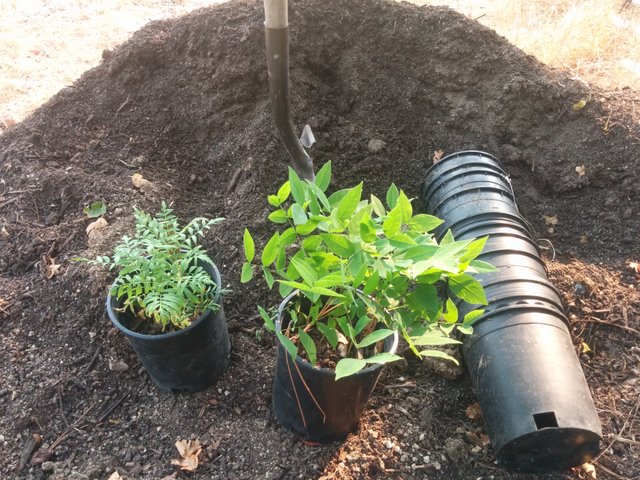
These young trees look very healthy and have been growing vigourously, but as you can see from the yellowhorn on the left in the above picture, the edges of the leaves are starting to yellow - a sign that perhaps they are drying out too fast between waters.
Note about the soil & timing
First of all, you might like to know about the soil mix I am using for the potted trees I am using compost purchased from a local organic composting operation by the truckload. I believe it is 40% organic dairy manure and 60% green waste/compost. I mix roughly 8 parts compost with 1-2 parts course sand for better drainage. I may also add eggshells, bonemeal or kelp to this soil for more minerals.
Time of day is important- morning or early evening are better time of days to work with potting up trees during the hotter parts of the year. If you can't manage that, working in the shade is imperative to keep the trees from stressing too much.
Let's start with the Kentucky Coffeetree
This tree is in the Fabaceae family and bears large pods containing seeds. Both of which are edible. The roasted seeds are said to taste like chestnuts and can also be roasted and ground as a caffeine free coffee substitute.
I am excited about this tree because I would guess like most Fabaceae's it would be a vigorous grower and producer. How great would it be to easily collect numerous pods, thresh them and have copious amounts of chestnut like protein that can be roasted and eaten?
Checkout Plants for a Future for more info about the Kentucky Coffee tree propagation and uses.
I did not have to cold stratify these seeds but I did scarify them by scratching them with a file and soaking in warm water overnight. They swelled up visibly and those that did not got scratched some more and soaked again until they did. Then I put them out in pots and kept them regularly watered until they sprouted!
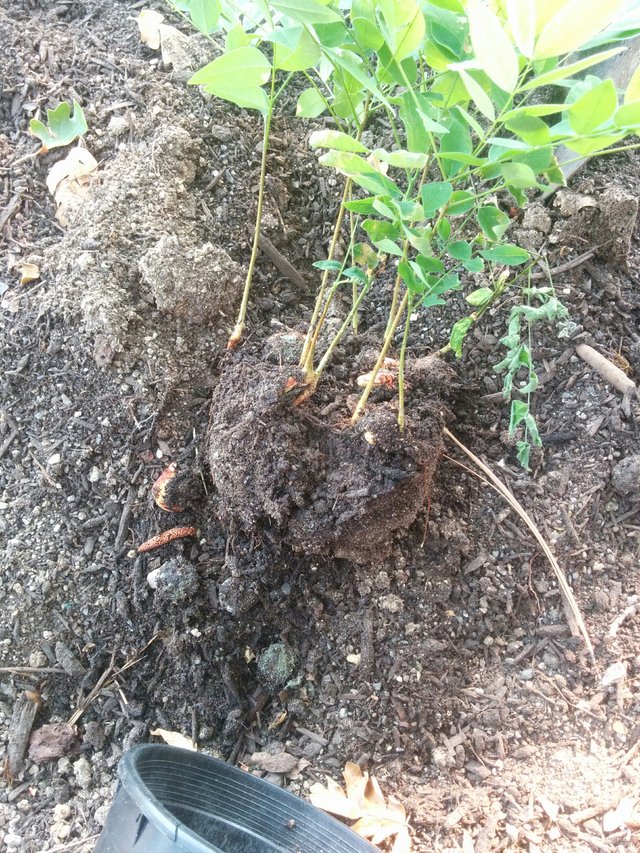
Here I gently pulled the seedlings with roots and soil out of the pot and laid it on its side.
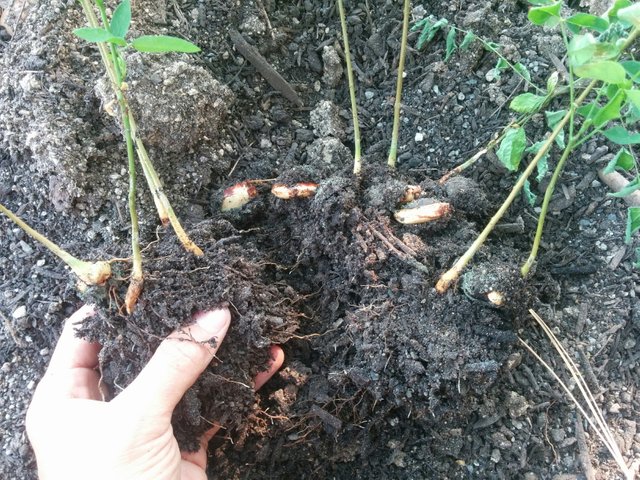
I start to tease apart the trees trying not to disturb the roots too much.
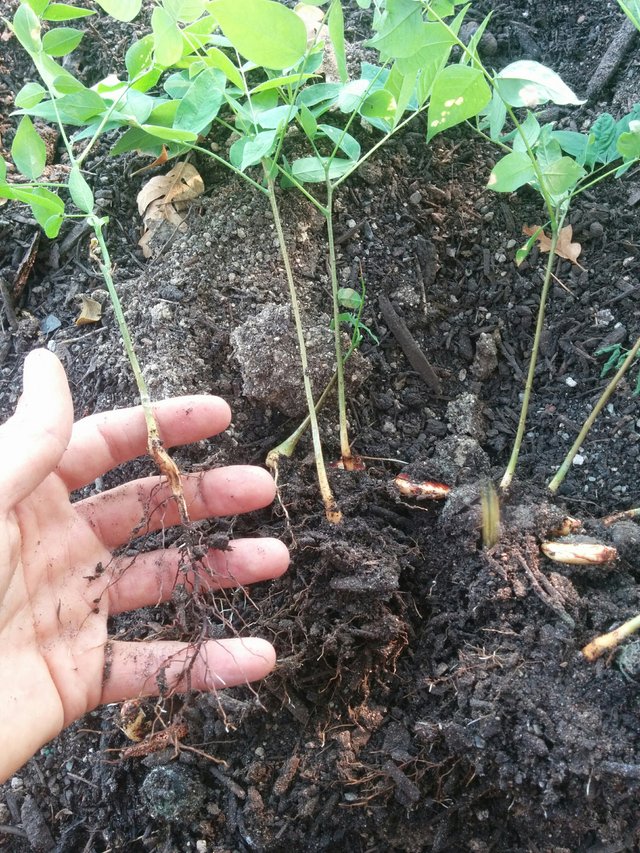
In this case the soil came completely free of the roots - if it happens that's OK, I'll take care to be gentle with the roots.
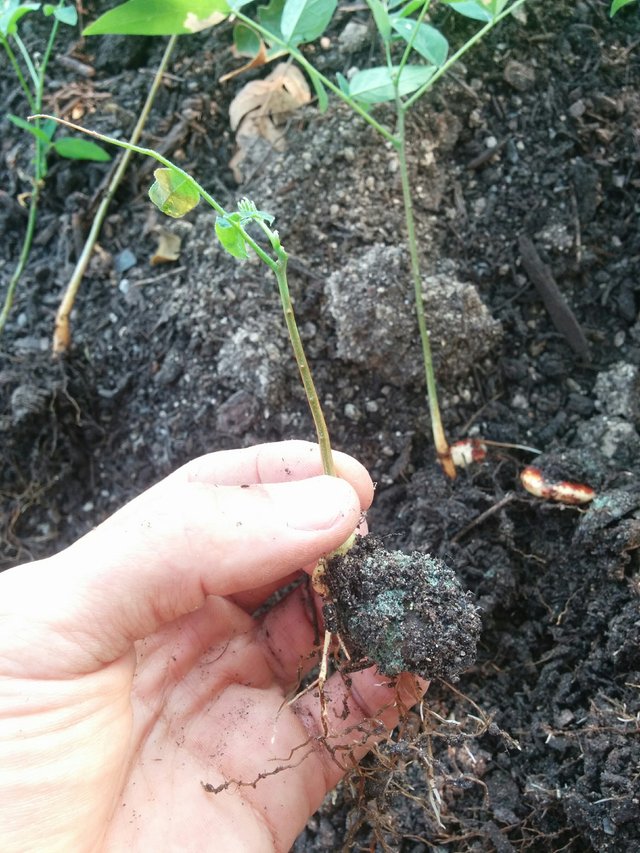
Here's one tree with the bean still attached and supplying carbohydrates to the young seedling.
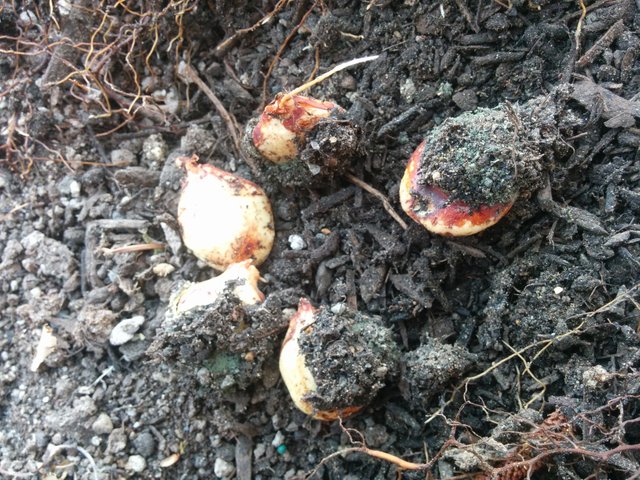
I found a few beans that hadn't sprouted yet or are just starting to sprout.
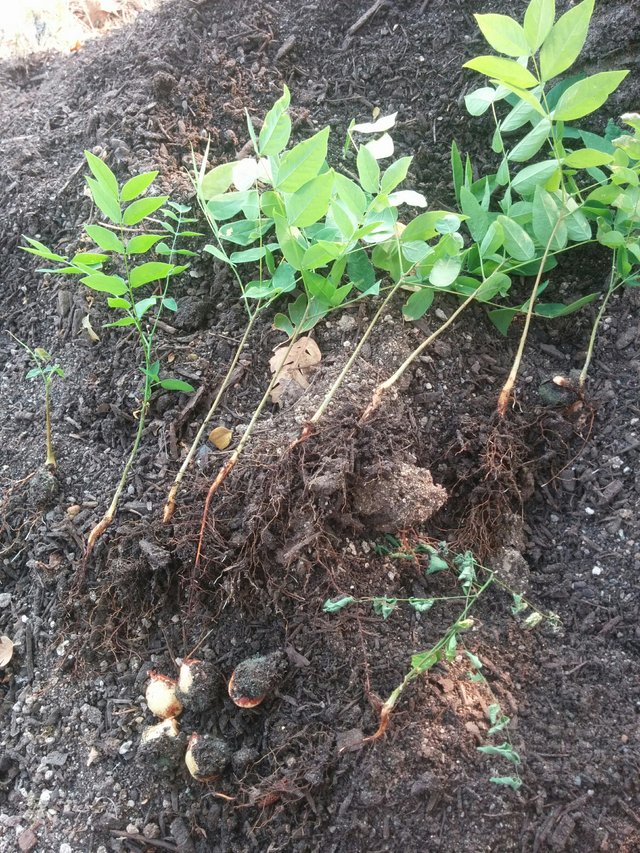
Here we are! 8 Trees, 5 un-sprouted beans and one tree that is dried up but I haven't 100% given up on yet.
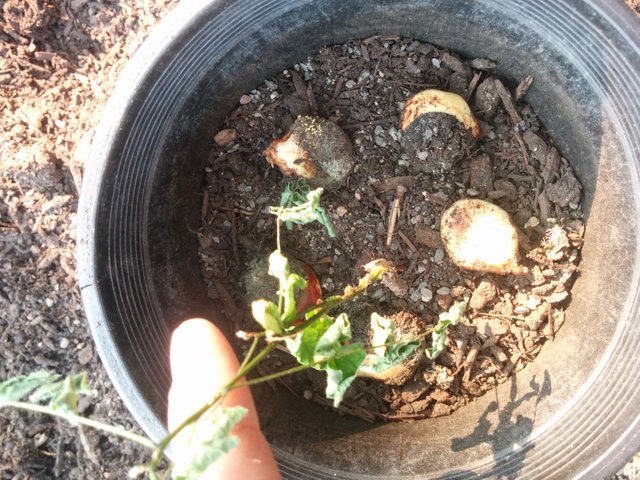
First I put the unsprouted seeds into a pot of soil, along with the almost dried up tree in case it makes it.
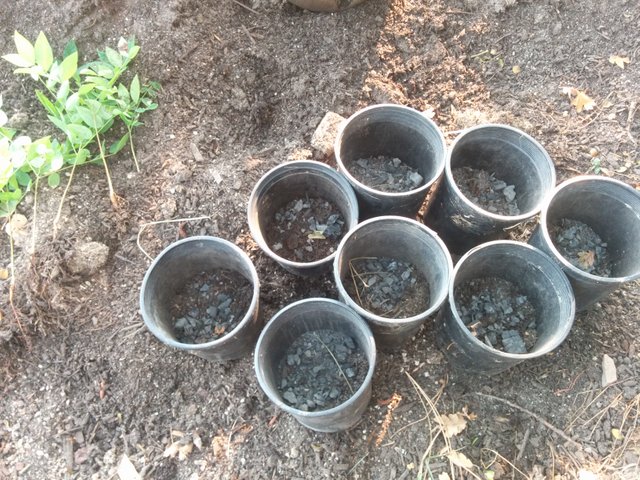
Cover it up with some more soil, label it and set it aside for now.
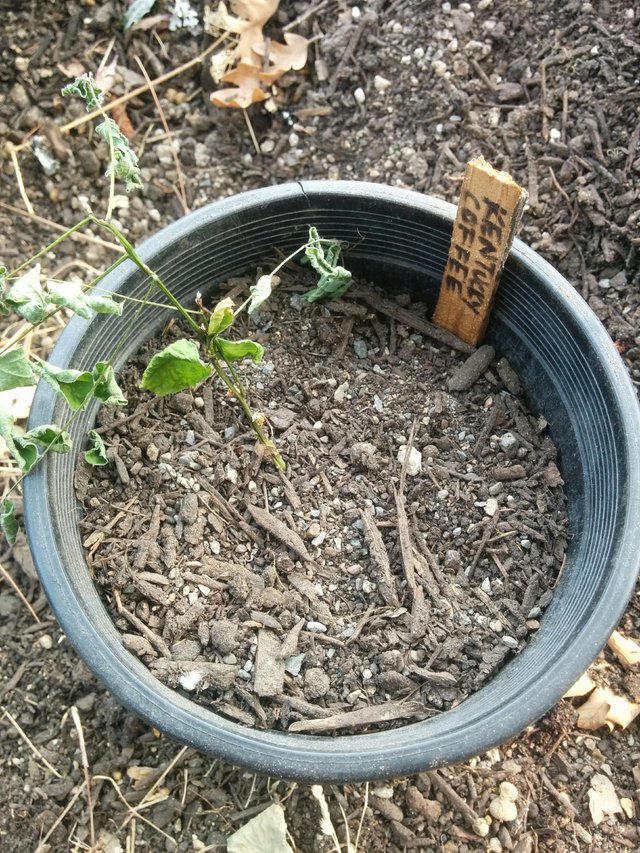
Now I am preparing some pots for the new trees. I fill them about 1/4 with soil and add a small handful of biochar that I made earlier this year. The amount of soil in the bottom of the pot really depends on how big the roots of the tree are - we want enough space for the roots. Allow me to demonstrate:
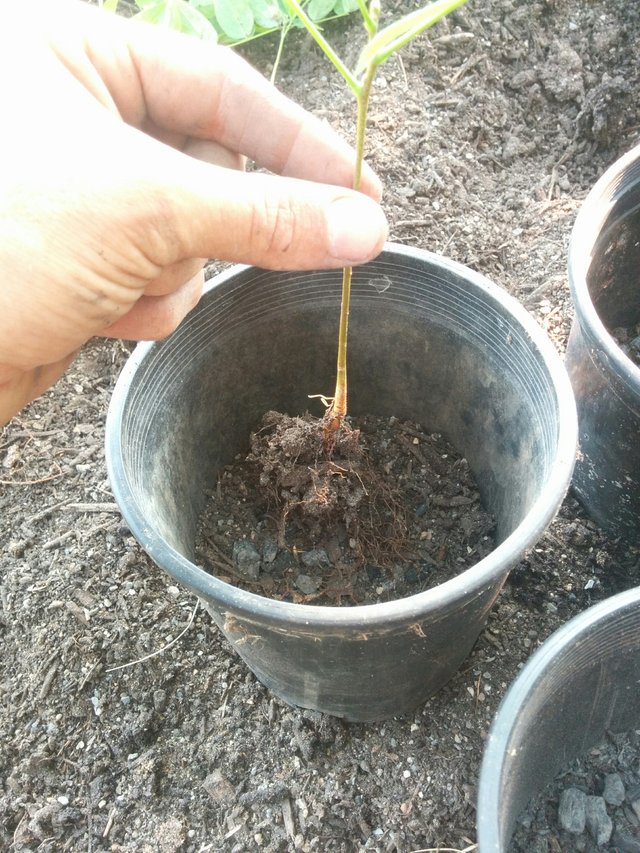
I like to hold the tree with one hand while I scoop soil in with the other hand. This lets me ensure the proper height of the tree in the pot.
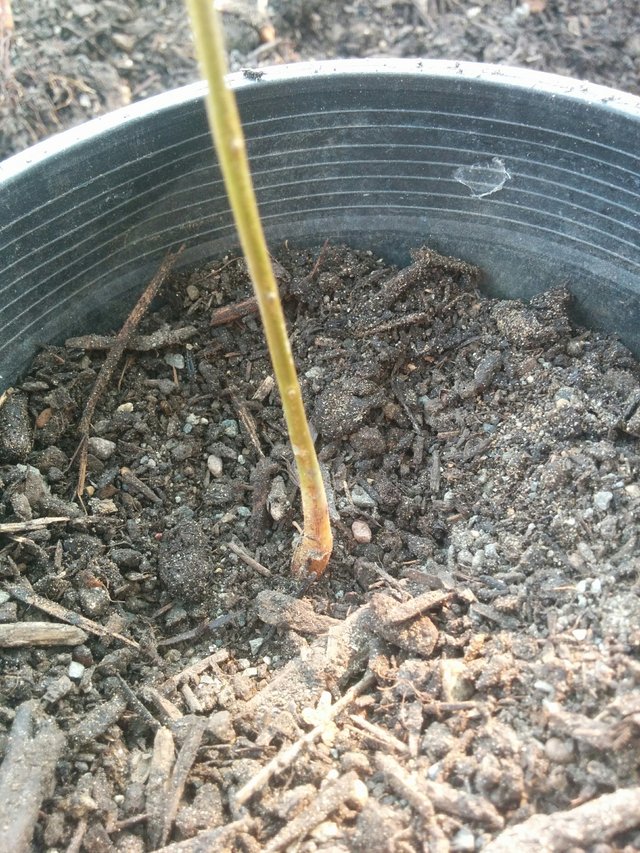
You can tell where the soil level was previously because the color of the trunk changes from light/white to green. I'll match the new soil height to a similar level. I like to leave some space between the soil and the top of the pot for watering.
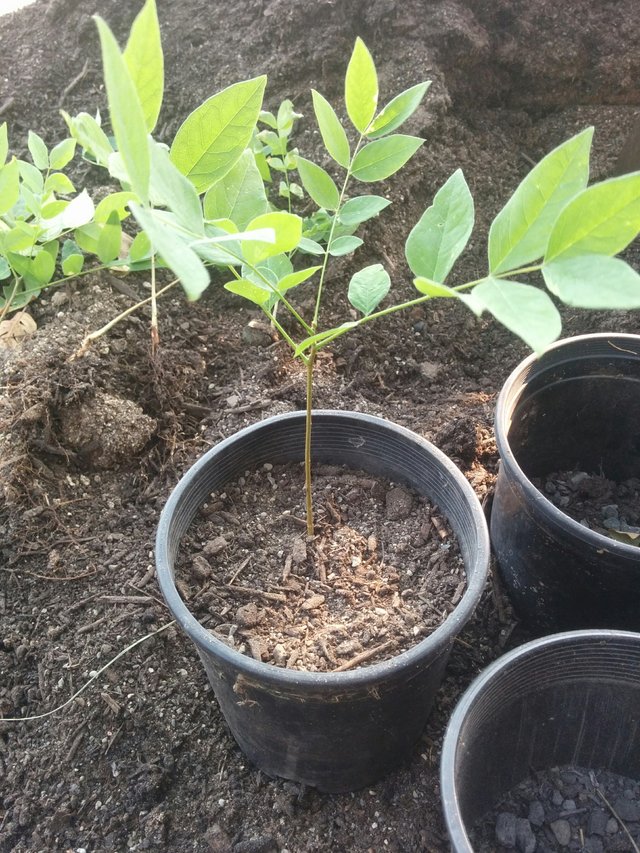
Here is the finished up-potted kentucky coffee tree!
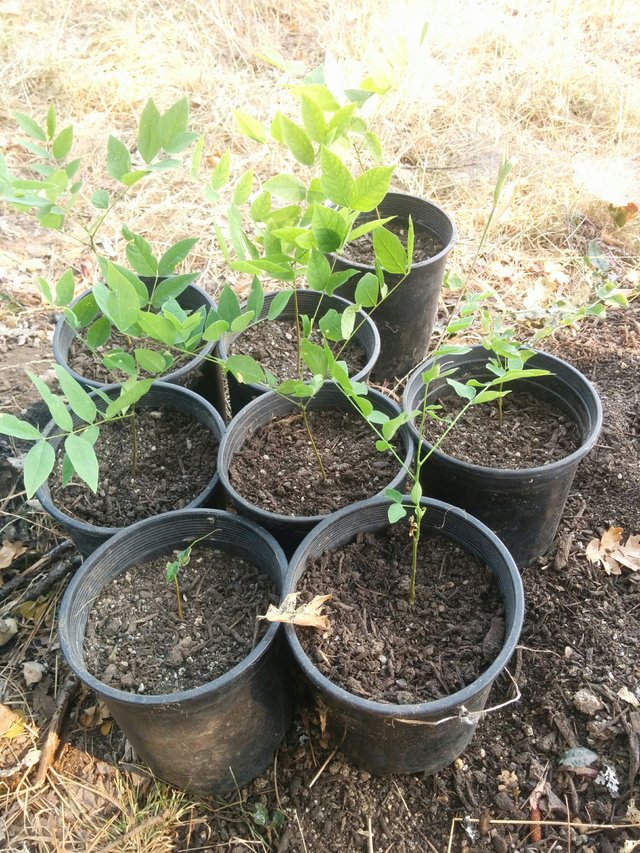
And here are the whole bunch, looking nice :)
I'm starting right in on the Yellowhorn now.
Yellowhorn is in the Sapindaceae which interestingly is the same family as the Lychee. Both the young leaves and the seeds are edible and supposedly delicious. The seeds have me interested - they seem prolific and can be boiled, dried and ground into flour or pressed into oil. How amazing would it be to have protein falling from the sky? I think this tree would make a fantastic fodder tree as well.
Here is a fantastic writeup on Yellowhorn as a permaculture tree.
I did cold stratify the yellowhorn seeds for 3 months in my fridge. It is pretty amazing that several already sprouted.
Potting up the Yellowhorn is the same process!
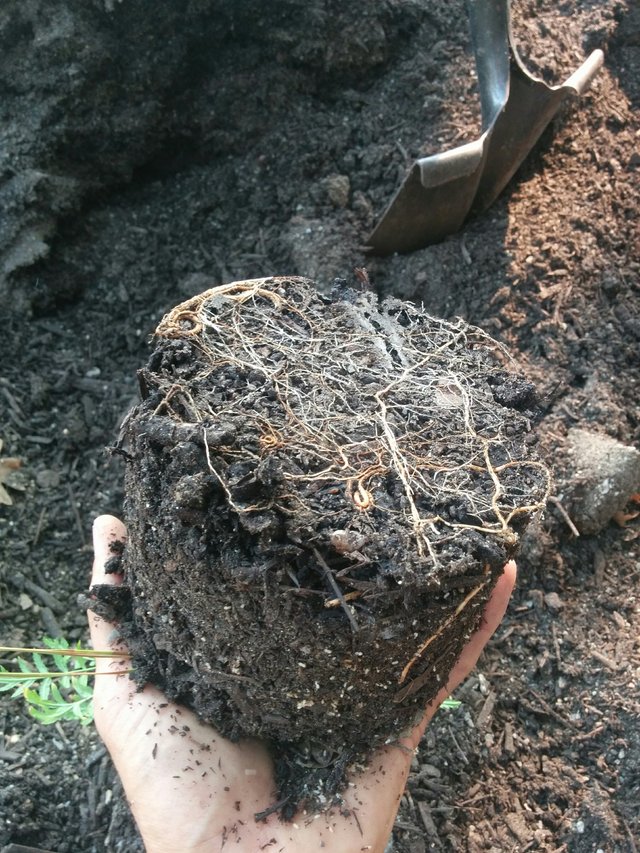
First thing I notice when I pull the trees out of the pot is the roots are just starting to matt up at the bottom. This tells me the yellowhorns have pretty vigorous tap roots. No wonder the leaves were getting a little yellow. Good thing we are potting them up now - and hopefully they wont live in pots too long.
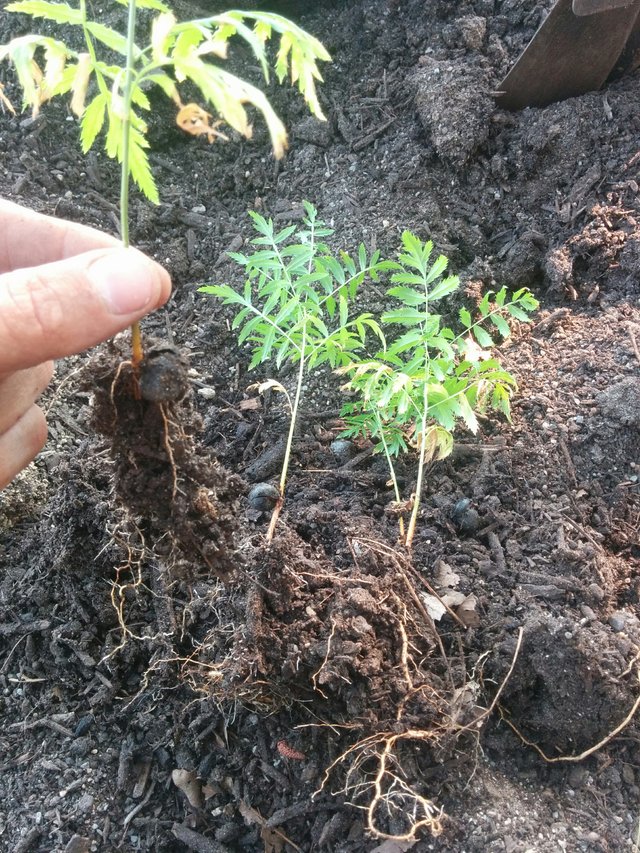
Again I carefully separate the trees from each other.
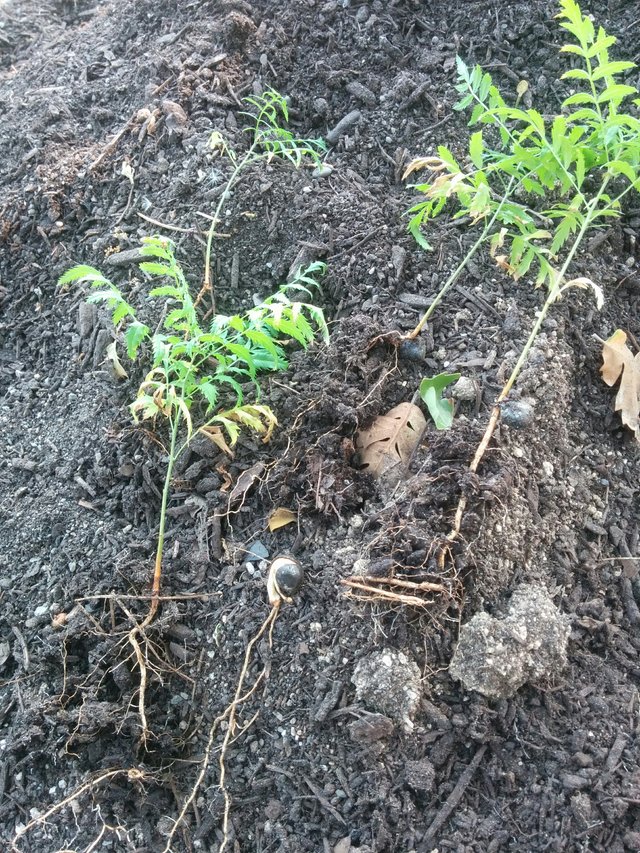
Here they are individually now. Boy their roots sure are long already!
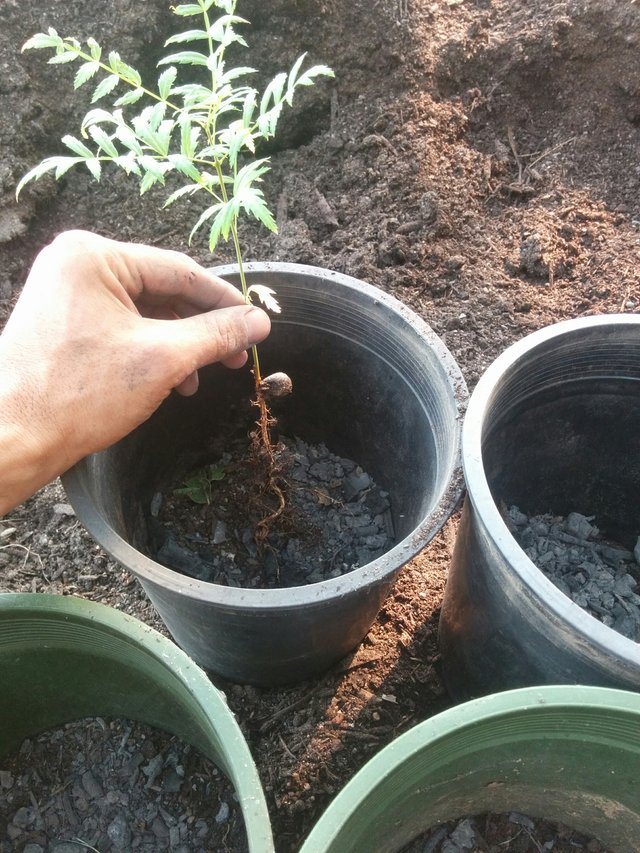
I am putting them into 2 gallon pots - 1 gallon is too small I feel for these roots. They may even outgrow the 2 gallon pots soon and need to be potted up again before long, we'll see.
Back in the nursery
The Kentucky Coffeetrees (front left) and Yellowhorns (front right) are back at home with their friends and graduated up to the big boys and girls section! Everyone is watered in nicely.
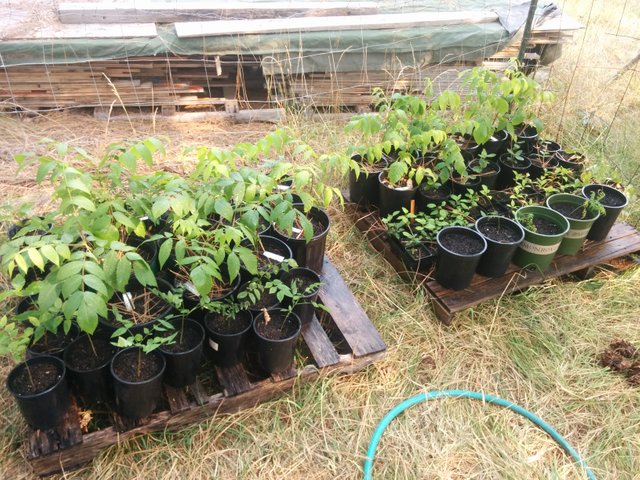
There are many more seeds in pots that I am waiting on patiently.
Some may sprout this season, some may take 2 or more seasons to sprout and some may never sprout. But in the meantime there are several other trees that have sprouted recently and will need to be potted up soon! It's an ongoing process :)
I'll be happy to share more with you as I continue working in the nursery.
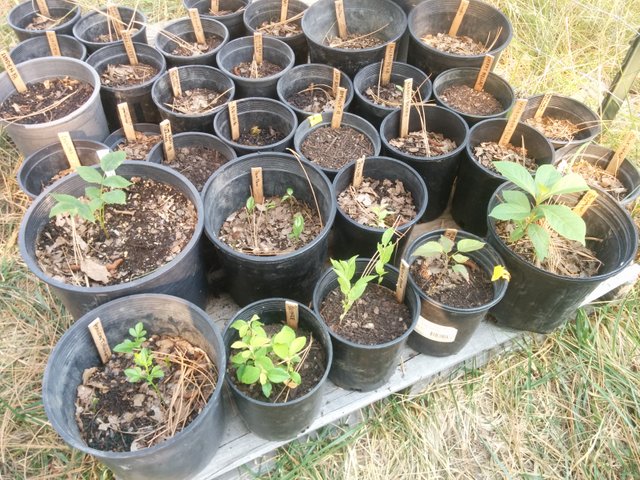
Very nice collection you have created. Don't you love looking at the roots when they are spread out nicely through the soil?
The one tree is looking a bit lanky. Hopefully it toughens up.
Did you purchase seeds, or acquire them? Obviously you have access to all kinds of seeds, but I am curious what attracted you to these types of trees to start from seed.
Thanks @creativetruth! I sure do love looking at the roots! The real thing is so beautiful, but Robert Kourik's books are next best :)
Many seeds are purchased and many are acquired or saved. In this case both of these were purchased but they were part of a bulk bundle of seeds I bought from someone that decided not to go through with their food forest. I got a good deal and acquired some species that I probably wouldn't have tried otherwise, including these two! In general I want a diverse approach to species in my future food forest so I am certain I will always be trying new trees every year :)
Looks like you will have a little forest when all of those grow. Do you have plans already for the future of the trees?
Aside from planting a food forest, enjoying connecting with nature I hope one day to have more food than my family needs so I can share it with others, have an income or employ others or all three as the needs may be. I cannot predict my needs 10-20+ years from now but I will always need food and medicine and the earth needs more trees.
Sounds like you have lots of space for growing things then?
I grew up with a wide assortment of fruit trees. We preserved food in the summer so had fruit to eat year round.
Not yet but we are looking for a future homestead. Patiently waiting and sprouting seeds in the meantime :) Nice going with your preservation! We are in full harvest/preserving mode right now too!
Things have changed a lot since I was young. I am just recently getting back to some of that. I spent my young adulthood living in larger cities. But have recently come back to a more rural environment.
Very smart move to start your trees now. When you get the homestead you will have a great head start. Especially since trees take so long to be productive.
Hello that is a pretty interesting post very well detailed! How long can you leave your trees in there pots now?
Trees can be in pots indefinitely if they have enough nutrition and room for their roots. In this case these pots are too small for long term (more than 1-2 years) so if they don't go in the ground in that time they definitely will need bigger pots. I can give them more compost and foliar spray + ground kelp for extra nutrients while they are in pots. The faster the tree grows the sooner they need a bigger pot. Trees with fast growing taproots do better in the ground ASAP and may not thrive in pots.
1 or 2 years ok so that is a pretty long time before you need to swap pot. Thanks for your answer:)
I would love to be doing that! I have lived on farms, but not for years. Digging in the dirt is the best therapy, and having such great results must so satisfying.
I went to your link for the Kentucky Coffee Tree. I have never heard of this before but I'm glad I know about it now. I hope you get to the point of posting about a harvest for it. I drink all kinds of odd concoctions and I think this one would be a keeper. And anything tasting like chestnuts would be on my list of favs :)
I totally agree! I did not grow up on farms so this life is relatively new to me the last few years... it sure is satisfying in a way I forgot since I was a boy. I hope I don't forget again.
I am glad you enjoyed learning about the Kentucky Coffeetree .. I did too and was fascinated when I first discovered it. There are so many unique and wonderful trees and plants out there for us to discover!
I wish I had the land to plant trees. I’m restricting myself to trees I can plant in containers.
Posted using Partiko iOS
I also wish I do have the land... but I plan to make that wish come true :) Right now we are renting/caretaking an off grid homestead until we find our long term place ... so I'm focusing on starting trees in pots until there is a place to plant them. If I don't find it soon I'll share some trees out to the community.
Oh I see. My family is also trying to find something. We currently have a house with too many rooms but not enough land. We are willing to revert the situation.
Posted using Partiko iOS
Hey dear @sagescrub , you provided the steemit community with great hints. Especially the good the idea to watch out the soil level 👍
Do you have a "adult" Kentucky Coffeetrees with beans ? I would be interessted how the taste of this Coffee 😃 is.
Greetings from germany , a country with much coffee drinkers, but not having much coffee plants :-D
Posted using Partiko iOS
No I have never seen an adult Kentycky Coffeetree in person. I do have more seeds that I did not germinate yet, maybe I should roast one or two and try them out sometime so I don't have to wait long to know! One thing to note though, is this does not have caffeine, so it is not a perfect substitute for coffee if that is what you want.
Hey, oh thanks for the Infos.
Hahha sometimes my english is not the best. :-) I meant full-grown tree , so you can pick up the beans from it, and make an coffee out of them.
But the question has nevertheless clarified ...
So for what would you use the beans instead?
As a bonsai tree hobbyist, may I insert some comments?
Every plant and tree has a different method. Do some research on the type you want to grow. Many tropical seeds will sprout just by keeping them in a plastic bag with a wet napkin, and kept in a warm windowsill. That's how I got my citrus trees started.
That is not true for all of trees. The trees in this post were started using scarification and stratification. Maybe @sagescrub can elaborate.
Awesome! I really love this kind of job, I have always dreamed of having a nice bonsai tree forest in the garden of my house. The scent that will fill all the garden will be just amazing! I will dig into some web material to learn how to properly grow those trees.
Right now I want to plant as many trees as I can, my house is near a place called "Los Guanabanos", it is the Spanish name for the Soursop tree. That place was called that way because of the huge number of those trees that once where all around...sadly today there is not even one left.
I intend to spread soursop trees everywhere in my city to recover these beautiful evergreen forests that we once had.
Best regards
That is great advice! In tropical environment I am guessing cold stratification is not needed except maybe for some species in higher elevations where it does get colder.
Moist, warm paper towel method is how I got started with seeds.. its a good place to start :)
Hey @joelsegovia! I don't have a LOT of experience with tropical trees but I can offer some advice:
I LOVE Plants for A Future database for finding Propagation and Cultivation notes about specific Species. You can search your favorite plants in their database. https://pfaf.org/ Sometimes it is hit or miss but often it is a hit!
Try an intro to horticulture book which would ideally outline basic propagation options such as Seed, Cutting, Root Division, Layering are the most common. Some plants work better with some propagation and not others.
When in doubt try a cutting or a seed in a pot and see what happens! It's fun to experiment.
Last but not least I recommend getting in touch with @el-nailul who is a tropical farmer and expert tropical plant propagator and I am sure he can answer your questions about specific species you are interested in.
Good luck!
Beautiful Article friend...
Congratulations @sagescrub! You have completed the following achievement on Steemit and have been rewarded with new badge(s) :
Click on the badge to view your Board of Honor.
If you no longer want to receive notifications, reply to this comment with the word
STOPHi sagescrub,
Visit curiesteem.com or join the Curie Discord community to learn more.